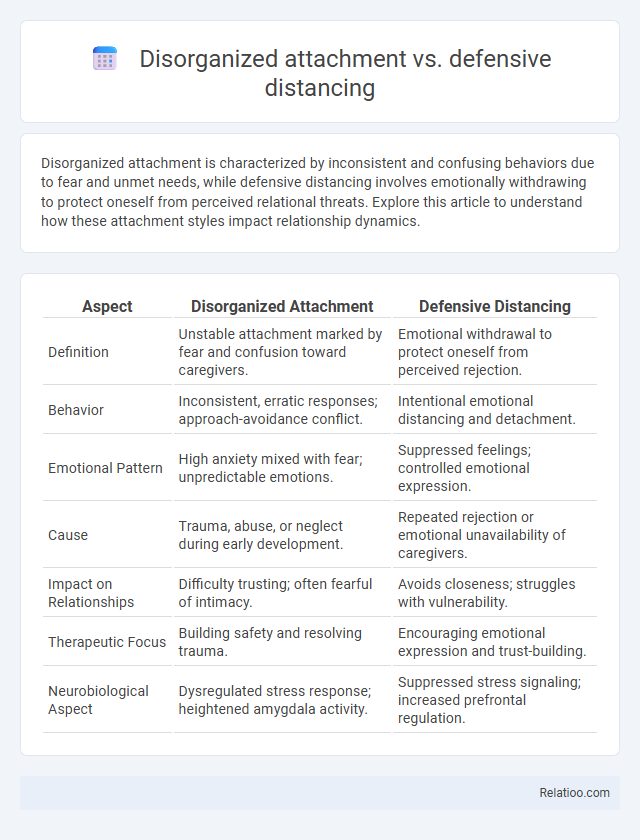Disorganized attachment is characterized by inconsistent and confusing behaviors due to fear and unmet needs, while defensive distancing involves emotionally withdrawing to protect oneself from perceived relational threats. Explore this article to understand how these attachment styles impact relationship dynamics.
Table of Comparison
| Aspect | Disorganized Attachment | Defensive Distancing |
|---|---|---|
| Definition | Unstable attachment marked by fear and confusion toward caregivers. | Emotional withdrawal to protect oneself from perceived rejection. |
| Behavior | Inconsistent, erratic responses; approach-avoidance conflict. | Intentional emotional distancing and detachment. |
| Emotional Pattern | High anxiety mixed with fear; unpredictable emotions. | Suppressed feelings; controlled emotional expression. |
| Cause | Trauma, abuse, or neglect during early development. | Repeated rejection or emotional unavailability of caregivers. |
| Impact on Relationships | Difficulty trusting; often fearful of intimacy. | Avoids closeness; struggles with vulnerability. |
| Therapeutic Focus | Building safety and resolving trauma. | Encouraging emotional expression and trust-building. |
| Neurobiological Aspect | Dysregulated stress response; heightened amygdala activity. | Suppressed stress signaling; increased prefrontal regulation. |
Understanding Disorganized Attachment
Disorganized attachment is characterized by conflicting behaviors and a lack of a coherent strategy for seeking comfort, often stemming from a caregiver who is both a source of fear and reassurance. Defensive distancing involves emotionally or physically withdrawing to protect oneself from perceived threats, commonly developing as a coping mechanism in response to inconsistent or frightening caregiving. Understanding disorganized attachment is crucial for recognizing how these contradictory responses impact emotional regulation and interpersonal relationships, highlighting the need for therapeutic interventions focused on safety and trust-building.
What is Defensive Distancing?
Defensive distancing is a psychological strategy where individuals intentionally create emotional or physical space to protect themselves from perceived threats or discomfort in relationships. It differs from disorganized attachment, which involves inconsistent and confused behaviors due to fear and anxiety, and defensive distancing is more about deliberate avoidance to maintain personal boundaries. This coping mechanism helps reduce anxiety by minimizing vulnerability and limiting close emotional engagement.
Key Differences Between Disorganized Attachment and Defensive Distancing
Disorganized attachment is characterized by inconsistent, confused behaviors toward caregivers, often stemming from fear or trauma, while defensive distancing involves deliberately creating emotional space to protect oneself from perceived relational threats. The key differences lie in the underlying emotional mechanisms: disorganized attachment emerges from unresolved fears leading to contradictory responses, whereas defensive distancing is a conscious strategy to manage emotional vulnerability. Disorganized attachment typically reflects early relational trauma, whereas defensive distancing can develop as a coping mechanism in various relational contexts.
Core Features of Disorganized Attachment
Disorganized attachment is characterized by contradictory behaviors, confusion, and fear toward caregivers, often resulting from inconsistent or frightening parental responses. Defensive distancing involves emotional withdrawal as a self-protective strategy to manage anxiety in relationships, reducing vulnerability but potentially hindering intimacy. Core features of disorganized attachment include a lack of coherent strategy to seek comfort, simultaneous approach-avoidance tendencies, and elevated risk for emotional dysregulation and impaired social functioning.
Signs and Behaviors of Defensive Distancing
Defensive distancing manifests through emotionally withdrawing, reduced eye contact, and minimal self-disclosure to protect oneself from perceived relational threats. Unlike disorganized attachment, which shows inconsistency and confusion in seeking comfort, defensive distancing involves deliberate avoidance and maintaining physical or emotional space. Key signs include reluctance to engage intimately, avoidance of vulnerability, and quick shifts to neutral topics during emotional conversations.
Impact on Relationships and Emotional Health
Disorganized attachment often leads to difficulties in forming secure bonds, causing increased anxiety and emotional instability in relationships, while defensive distancing serves as a coping mechanism to protect against further emotional harm, frequently resulting in reduced intimacy and trust. Defensive distancing, though similar, specifically involves maintaining emotional space to avoid vulnerability, which can create barriers to deep connection and contribute to feelings of isolation and unresolved emotional distress. Both behaviors significantly impact emotional health by fostering patterns of mistrust and emotional dysregulation, ultimately hindering healthy relational development and emotional well-being.
Root Causes: Origins of Disorganized Attachment vs Defensive Distancing
Disorganized attachment originates primarily from inconsistent or frightening caregiving during early childhood, causing a lack of coherent strategies for managing stress or seeking comfort. In contrast, defensive distancing stems from learned emotional self-protection mechanisms, often developed through repeated relational trauma or neglect, leading individuals to maintain emotional or physical distance to avoid vulnerability. Both arise as adaptive responses to adverse childhood experiences but diverge in behavioral outcomes and relational dynamics.
How Childhood Experiences Influence Patterns
Childhood experiences with inconsistent caregiving often lead to disorganized attachment, where Your emotional responses are unpredictable and conflicted. Defensive distancing arises when past neglect or trauma causes You to create emotional space as a protective mechanism. Patterns formed in early relationships shape how individuals manage closeness, trust, and vulnerability throughout their lives.
Effective Strategies for Healing and Growth
Disorganized attachment and defensive distancing both stem from early relational trauma, but disorganized attachment is characterized by conflicting behaviors toward caregivers, while defensive distancing involves emotional withdrawal to protect oneself from perceived threats. Effective strategies for healing and growth include trauma-informed therapy, such as EMDR or somatic experiencing, which helps You process unresolved fears and develop secure relational patterns. Building self-awareness, establishing safe boundaries, and fostering consistent, empathetic relationships are essential for overcoming these attachment disruptions and creating lasting emotional resilience.
When to Seek Professional Help
Disorganized attachment often results in unpredictable emotional responses and difficulty forming stable relationships, signaling a need for professional intervention when these patterns cause significant distress or impair daily functioning. Defensive distancing, characterized by emotional withdrawal to avoid vulnerability, warrants therapy if it leads to chronic isolation or interferes with intimate connections. Seeking professional help becomes crucial when these behaviors disrupt personal well-being, relationships, or mental health, allowing for targeted strategies to develop secure attachment and healthy relationship dynamics.

Infographic: Disorganized attachment vs defensive distancing
 relatioo.com
relatioo.com